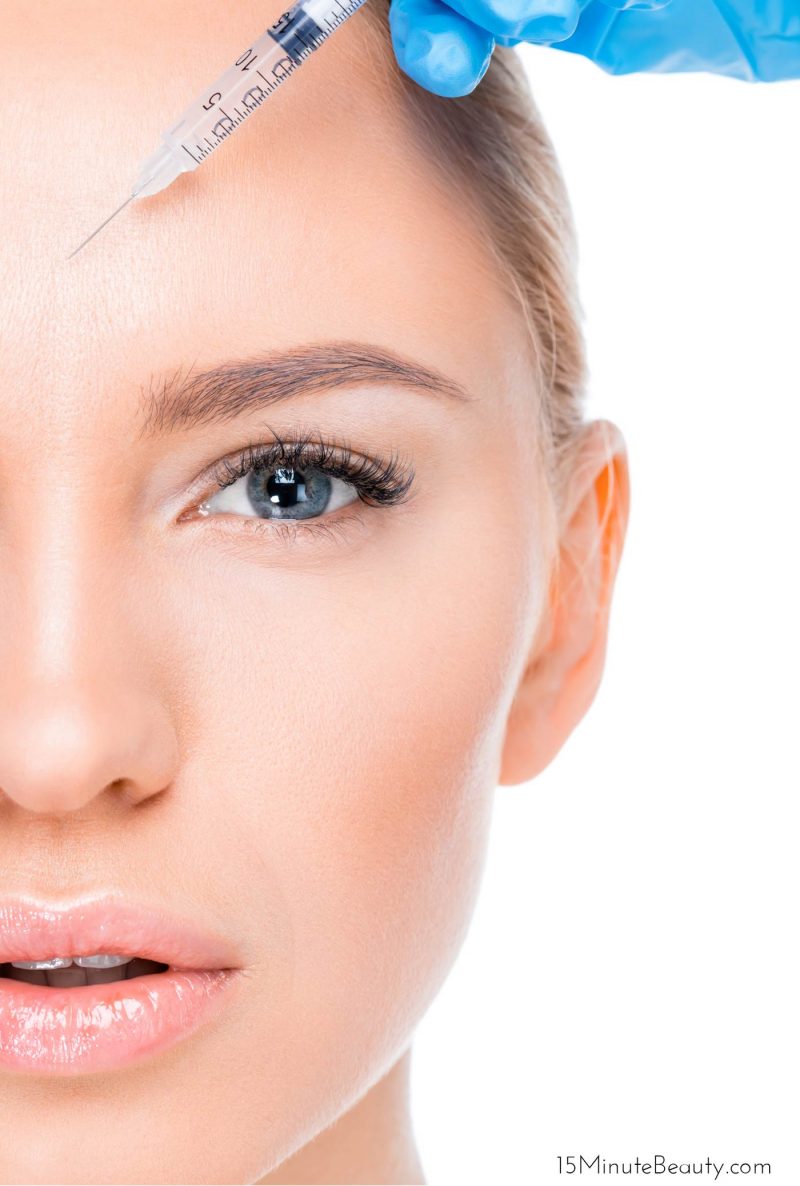Have you been thinking about getting Botox? I’ve been getting a lot of questions from readers about Botox, laser resurfacing and laser hair removal. Since these topics are not my medical speciality, I’ve called upon my friend Dr. Jennifer Greer, a board certified plastic surgeon in Cleveland. She has a plastic surgery blog with more topics, but watch for more posts from her here on 15 Minute Beauty as well!
Does Botox look natural?
When I see new patients who want Botox for the first time, one common concern is looking weird or unnatural. Today I’m going to explain to you what I teach my patients: namely, why bad Botox happens, and how to prevent it. I actually use two different neurotoxins in my practice: Botox and Xeomin. But they are very similar, and for the sake of simplicity I will refer to both neurotoxins as Botox.
How does Botox work?
Botox is a neurotoxin produced by a species of bacteria called Clostridium botulinum. The toxin blocks the communication between nerves and muscles. So injecting small amounts directly into a muscle results in paralysis of that muscle because it can no longer receive a signal from the nerve to contract. The effect is temporary, and lasts about three months. As you may have noticed from the name, Clostridium botulinum is the bacterium that causes botulism. When the bacteria are ingested the toxin affects all the muscles in your body, which can be fatal (goodbye breathing!). But injecting a very small amount of toxin directly into a single muscle has been researched extensively, and is very safe.
Botox only works on wrinkles that result from motion, known as dynamic rhytids. Botox does not affect static wrinkles, i.e. wrinkles that are present even if you aren’t moving your face. You may need fillers or laser resurfacing to see improvement in static wrinkles.
Where is Botox used?
Dynamic wrinkles are most common over the forehead, on the frown lines between the eyebrows (affectionately called the “elevens” by Allergen, the company that manufactures Botox), and on the crow’s feet around the eyes. So these are the areas where Botox is most useful. You may have heard of getting Botox around the mouth. I will occasionally, and very cautiously, inject Botox in this area. But using too much Botox or putting it in the wrong place can cause difficulty speaking and eating. If you’ve ever seen Christmas with the Kranks, the scene where Tim Allen is drooling after getting Botox is a greatly exaggerated example of what could happen if you were to get too much Botox injected around the mouth. (It would actually take 5-7 days for the Botox to kick in, but then the movie wouldn’t be as funny.)
So why does Botox make people look fake?
There are three common examples I see of unnatural Botox:
If your face is totally frozen.
I think we’ve all seen that expressionless person who wouldn’t blink an eye if she had a gun pointed at her face. You know. Because she can’t. If you want your Botox to look natural, I think your face should move at least a little bit. Granted, I have patients who like that totally frozen look, and I’m happy to tailor my treatment to their preferences. But my go-to treatment result is very natural.
The Spock eyebrow.
Injecting Botox over the forehead is a little tricky. If you inject too far to the sides, patients will complain their eyebrows feel heavy. But when Botox is injected only over the central forehead, the lateral brow can arch too much and give you that unnaturally arched eyebrow which makes you look like an extra in Star Trek. Fortunately this is totally correctable; injecting a little Botox over the lateral forehead will take care of the problem.
The eyelid droop.
Drooping of the upper eyelid can happen when Botox diffuses into the muscles that raise the upper eyelid. This is thankfully very rare; in the past six years I’ve been in practice I’ve never seen it happen. The eyelid droop does go away in a couple of months when the Botox wears off, and eye drops can improve it in the meantime.
How do you get natural-looking Botox?
Now that you know what causes Botox gone wrong, how do you avoid it? If you want a good result, go to a good doctor! Injecting Botox is legal for all kinds of medical professionals, from dentists to family practitioners. But you want someone with focused training in aesthetics and facial anatomy, which means you want to see a board-certified Plastic surgeon. You can find one in your area at www.plasticsurgery.org.
Dr. Greer is a Plastic Surgeon who practices in Cleveland, OH. Her passion is helping moms regain self-confidence by getting rid of sagginess, wrinkles, and stubborn fat. Read more at her blog.


 I’m a doctor, a mommy and a bit of a beauty addict. If you let me, I can take 2 hours to get ready in the morning. Really. I'm on a quest for faster beauty that works!
I’m a doctor, a mommy and a bit of a beauty addict. If you let me, I can take 2 hours to get ready in the morning. Really. I'm on a quest for faster beauty that works!
Hi doc, what do you think about botox and fillers while breastfeeding? I was told purely hyaluronic acid may be safe?
That’s definitely outside of my expertise. I would only get things like that done with a physician ever, but especially when nursing. I would discuss with them.